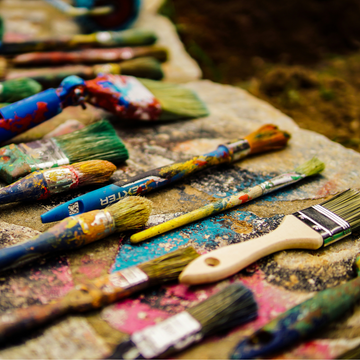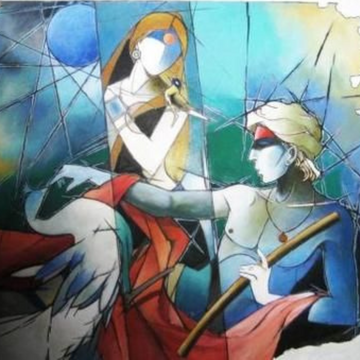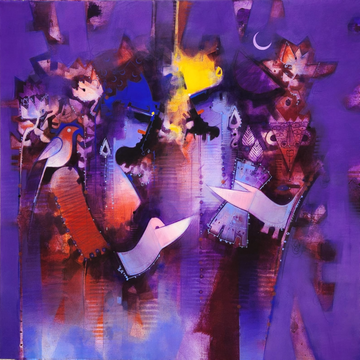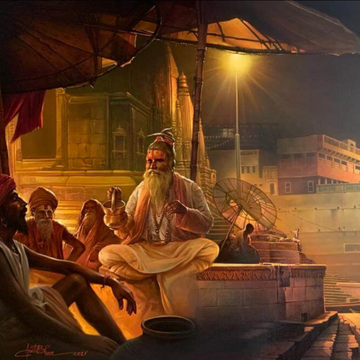Artist vs. The Canvas: Painting Techniques

Author-Ria Sarkar, For Eikowa
Painting is one of the most expressive visual languages in the world of art. When we see a painting, we look at the story an artist has created in a two-dimensional space, often transporting us to a different place, a different time, or even a different world. But for a layperson, essentially it is just paint on a surface. So how did it get there and what is it made of?
There are a plethora of painting styles, techniques and mediums that artists have been playing around with since ancient times. The use of mediums such as tempera, oil, acrylic and watercolor is determined on the basis of their compositional features that can help the artist best express himself on a visual plane. The choice of a particular medium or technique is heavily dependent on the possibilities and limitations of the paint itself. Although unlike today’s artists who have the freedom to explore a wide range of media, in ancient and medieval times we find that more often the medium chose the artist.
Read on to discover some of the major techniques that exist in Fine art painting and exactly how they were developed.

Watercolor
A household favorite that is generally included in school curriculum worldwide, Watercolor is one of the most versatile mediums in Fine art painting. As the term suggests, 'Water-color' is a medium in which color pigments are combined with water-soluble agents. Initially these binding agents were made of animal glues and sugars, but since 19th century the preferred substance is natural gum arabic. These binders help fix the colors to the painting surface while water, which can be added to dilute or mix colors, later evaporates as the color pigment solidifies. Honey and glycerin are often added to the mixture in order to increase plasticity and/or solubility. In 'pure' watercolor painting, no white is used. The areas left unpainted depict the objects that are white, leaving the artist no room for errors. This is a distinctive feature of watercolor painting that differentiates it from similar mediums like Gouache.
Interestingly, while the European painters from the Romantic period (Turner, Constable, etc.) popularized watercolor painting as we know it today, it originated much before the Europeans discovered its use as a versatile technique. Chinese and Japanese Art dating as far back as 4000 BC consists of landscape painting made in watercolors on woodblocks. As it dries faster than oils or acrylics, the painting surface has diversified over time and across regions from wood blocks to paper, canvas, stone, fabrics and so on. The fast drying time also makes it a medium that offers more precision and finesse for the skilled artist. Despite its universal appeal, watercolor works tend to fade with continued exposure to light thereby making it difficult to conserve from an artistic standpoint.

Gouache
A quick drying medium, Gouache originated in Greece and appeared in European art around early 14th century. Unlike watercolor it was not a very popular medium and was used mainly to create specific effects in paintings.
From a compositional angle, Watercolor and gouache are like peas from the same pod. As mediums, they provide very similar results and are often used together by artists to achieve the desired effects. The only point of difference between the two comes down to one component – chalk. To create gouache paint, the same ingredients as watercolor i.e. color pigments and gum arabic are used, with the addition of an inert material such as chalk, which creates an opacity and generates a reflective quality that is missing in watercolors. The addition of chalk gives the paint a thick, whitish sort of look that allows the artist to stack on multiple layers of paint and correct mistakes by repainting. But applying the paint too thick can cause it to crack easily, especially if there is a high percentage of chalk.

Like watercolor, Gouache paints blend easily and can be used on various surfaces with different brushes and painting tools. Moreover, it can be applied in differing thicknesses to create impastos. It is perfect for poster art, comic illustrations and creating preliminary studies for oil and acrylic works.

Tempera
Tempera was one of the first mediums used to make murals in the ancient dynasties of Egypt, Babylonia, Mycenaean Greece, and China. It was also the dominant medium of Renaissance painting, and was used by every artist of that period at some point or the other. Derived from the Latin word ‘temperare’ meaning ‘to blend or mix’, in English the verb ‘temper’ means ‘bringing to a desired consistency’.
In Tempera works, dry powder pigments are ‘tempered’ with a binding agent such as egg and thinned with water before applying it onto a ‘gesso’ base made of burnt gypsum (Chalk or Plaster of Paris) and hide glue. The gesso is a smooth, white and highly absorbent base creating a light-reflecting surface that gives off a luminous quality. Although it is quick to dry and permanent once set, the gesso brings out an opacity and intensity of color characteristic of Tempera as a medium.
There are two types of Tempera that artists developed. The first one is called Distemper, which is a crude form made by mixing dry pigment into a paste with water and whiting (a mixture of fine-ground chalk and size). The end result of distemper is a pale, powdery sort of paint prone to smudging which is quite similar to pastels.
The second and more commonly used type is known as Egg tempera due to the inclusion of egg yolk, egg whites or the whole egg, depending on the preferences of artists. This is more durable and in hindsight has proven to be less affected by humidity and temperature. The soft, gleaming satin-like finish of egg tempera can be seen in Renaissance artist Botticelli’s works.


Fresco
Fresco painting is synonymous with the Renaissance in Italy, bringing to mind Michelangelo’s great fresco masterpiece – The Sistine Chapel. The origins of this medium are unknown, but it was used to make Murals as early as the Minoan civilization in Crete and many of the earliest cave paintings in India (Ajanta, Ellora caves). Despite its widespread use, post-Renaissance fresco painting gradually lost its popularity with the invention of oil paints and was briefly revived by Mexican muralists before it died out completely.
In this method, water-based pigments are painted onto a wet lime and sand plaster that is freshly laid on the walls. The colors consist of dry-powder pigments mixed in water that allows them to set with the plaster permanently once the water evaporates.
There are two kinds of Frescos – Buon fresco and fresco secco. Buon or ‘true’ fresco was preferred by the Italian masters for its durability and consists of three successive coats of plaster. The paint must be applied quickly while the last coat or ‘intonaco’ is still wet. When prepared properly, an intonaco retains its moisture for many hours giving the artist a short window period to trace and complete his work from a ‘cartoon’ or preparatory drawing.
Fresco ‘secco’ is a dry fresco where the paint is applied onto a dry finished wall. Since the plaster is already hardened and set, the colors are mixed with a binding agent like egg, glue or oil in order to fix them onto the painting surface. While this process is not as durable as the former, some artists preferred it for the longer working time and opportunity to repaint mistakes or add finishing touches. Indeed the Italian renaissance artists used this process on top of a buon fresco solely for the purpose of retouching.
 Michelangelo, Ceiling of the Sistine Chapel, 1508-12
Michelangelo, Ceiling of the Sistine Chapel, 1508-12
Encaustic painting
Encaustic painting is one of the oldest techniques that precedes oil painting and was dropped once more favorable mediums were discovered. Originating in Greece and described in detail by Roman scholar Pliny the elder, the genre reached its peak in 4th century BC. In this style color pigments are mixed with hot, liquid wax and after all of the colors have been applied to the painting surface, a heating element is passed over them until the individual brushstrokes fuse into a uniform film. This process of heating is known as ‘burning in’ of the colors, which gives the painting an attractive radiant effect, much like oil paintings when coated with varnish.
From the point of view of application, the wax and paint mix has to be kept warm until the very end and therefore was not a very practical medium for artists in 4000 BC. Even today with modern methods of heating, the technique has remained similar to its original process and is more of an experimental substitute for oil paints.


Oil Painting
Oil painting as a medium surfaced as early as 8th century CE in Bamiyan, Afghanistan. In Europe, where it grew to become one of the most popular mediums, it created a stronghold in the art world around 11th-15th century during the Renaissance period.
Oil colors are created by mixing dry powder pigments in various types of drying oils made from linseed, walnuts or poppy seed. Professional artists’ oil paints are made by grinding the components in steel roller mills into a smooth buttery paste to get that refined effect. Sometimes, in order to get a more flowing consistency, pure gum turpentine is added to the mix.
Until the 19th century, most oil paintings were created in a layered fashion. After a first blank layer of thinned paint (i.e. a ‘ground’), the images were built up in subsequent layers and rounded off with a final glaze of picture varnish, primarily meant for long term protection, but also to bring out the tonal depth and intensity of color originally envisioned by the artist.
Artists working with oil paints preferred using paintbrushes (red sable and bleached hog bristles) and painting knives, a slimmer version of the palette knife.

Impasto
We all love Van Gogh’s unique style of painting, but have you ever wondered about the technicalities behind creating ‘The Starry Night’ or his famous ‘Sunflowers’ series? Those bold, unblended brush strokes of color are known as Impastos.
When paint is applied on a canvas in quantities that make it stand out from the surface, the technique is called Impasto. Initially used to create highlights and textural three-dimensionality, the paint is applied with a brush or palette knife in a manner that makes each stroke identifiable. This style originated sometime during the Renaissance, and developed into a technique in the Baroque period around 17th century. Baroque painters such as Rembrandt used impastos with great skill to depict lines and wrinkles on the skin, or to produce shine and sparkle on armor, jewelry and rich fabrics. In the Modern era, impastos became bolder and clearer especially in Impressionist and Post-Impressionist paintings.
Impasto paintings are most often rendered in oil and acrylic paint, due to the thickness of these paints and their slow drying time. For the impasto to stand out, it is essential to use paints that do not merge together. They can also be rendered using watercolors, tempera and gouache by adding a thickening agent.

Vincent Van Gogh, Artist using a palette knife (detail)
Self Portrait with grey felt hat, 1887
Acrylic painting
Hailed as the second most popular medium since the Modern era (first emerged around 1960’s), acrylic colors are often preferred by professional artists for their durability and versatility. It is made up of color pigments suspended in acrylic polymer emulsion that are water-soluble, but become water-resistant when dry. The paint can be applied in thick or thin layers across any surface and still retain its vibrant quality. They can even be applied directly from the tube and the paint does not crack or fade.
For artists concerned about the health risks associated with oil paints such as inhalation of toxic fumes, acrylics are fume-free and continued exposure to them is not harmful. Moreover, these paints dry very quickly and when mixed with water or oils can be modified to create the transparency of watercolor as well as the density of oil paints depending on the desired effect. But due to the fast-drying time, mixing is favorable only for the skilled artists as dry paint can tend to ruin brushes and palettes. In fact the only drawback that keeps it from becoming the top choice as a medium is a slightly shiny plastic look that pure acrylic colors possess. Notable 20th-century artists who used acrylic paint include Pop artists Andy Warhol and Roy Lichtenstein and color field artist Mark Rothko.














